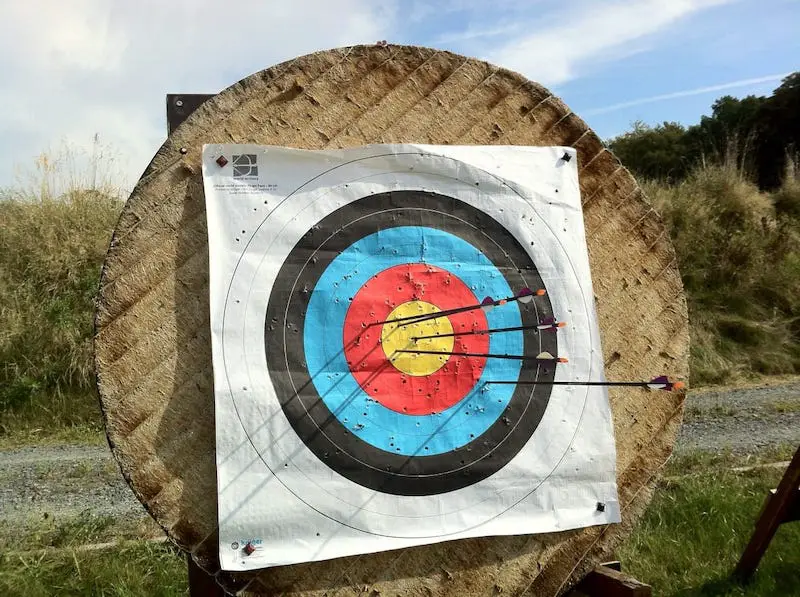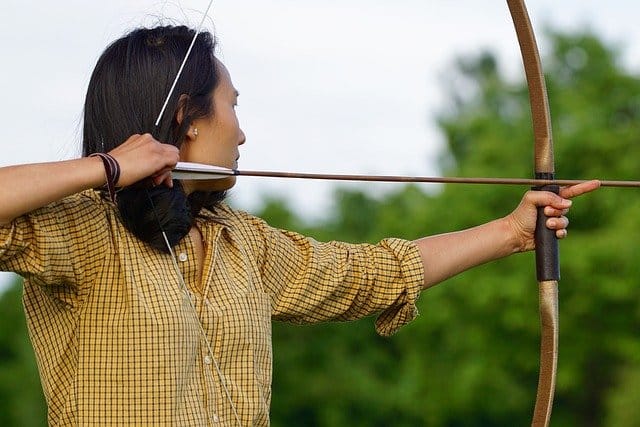When it comes to archery targets, there are a few different materials that can be used. The most popular options for DIY archery targets are cardboard, bales of hay, or foam. But also carpets, rugs, and rag bags are being used as material for archery targets. Each option has its own set of pros and cons that you’ll want to consider before making a decision.
When you need to practice archery, you aren’t limited to commercial targets that you can buy at the store. For archers on a limited budget – not wanting to buy an expensive archery target – a DIY archery target out of items from around the house can be a lot cheaper and help get you shooting more quickly since you don’t have to wait to buy targets.
In this article, you’ll find a list of some of the best items you can use for DIY archery targets. Some of these items are items you can find around the house, while others are items you’ll have to buy. Either way, you’ll have plenty of options for different things to aim at.
Read how to set up a complete indoor range.

Haystack and hay bales as material for DIY archery targets
Haystacks as archery targets are one of the oldest home-grown targets you’ll see around, and with good reason. For hundreds of years, medieval peasants and knights alike used haystacks and hay bales as target practice. Here are a few advantages of using haystacks as archery targets (Source: Archery 360):
- Affordable: A few straw bales of hay can be bought for less than thirty dollars, making this a good option for archers on a tight budget.
- Environmentally friendly: One of the benefits of using hay as a target practice is that you can break down the haystacks once they get tattered and reuse the hay in your garden. Hay works well as mulch around the base of vegetable plants and new trees. You can also throw used hay in the compost pile.
- Customizable targets: By stacking up hay bales, you can create a target as high off the ground as you want to set it. You could also try stuffing a scarecrow with hay to create a human-shaped target.
Haystacks are thick and wide, making them a smart way to provide a large hay archery target for novice archers. They are also relatively cheap and easy to set up. You can find hay bales at most farms. The downside to haystack targets is that they can deteriorate quickly if they’re left out uncovered in the rain. And also they can be difficult to transport if you need many small straw bales or some large big straw bales.
Cardboard as DIY archery target material
There are a few different materials that can be used for a DIY archery target, but one of the most popular and affordable options is cardboard. DIY cardboard archery targets are great because they are easy to set up and take down, and they can provide a good level of challenge for shooters of all skill levels. Plus, if you shoot regularly, you can simply replace the outer layer of cardboard when it starts to get worn out.
A DIY cardboard archery target is likely one of the cheapest archery targets you can throw together. Almost everyone has at least a few of these hanging around in the garage or a closet somewhere taking up space, so get a few boxes out and get started.
Note that compressed cardboard can potentially damage your arrows if they hit the cardboard at a slant rather than straight on, so be sure to inspect them carefully after using a DIY cardboard-based target to verify the tips are still good.
A simple way to use cardboard boxes in an archery target is to do the following (Source: Instructables):
- Take several cardboard boxes and cut a square out from one of them in the size and shape that you want your archery target. This will form your template.
- Using this cut-out, trace your target design on each of the subsequent pieces of cardboard and cut them out.
- Once your stack of cardboard pieces is several inches thick, take a roll of duct tape or two and carefully wind the tape around the stack of cardboard until there is a layer of duct tape all the way across holding the stack of cardboard together.
And voilà! You have a DIY cardboard archery target ready to go. If you want, you can use paint or a permanent marker to draw a bullseye on the cardboard face so that you can aim for specific areas on the target.
When shopping for cardboard, make sure to look for one that is made from thick, sturdy cardboard. The last thing you want is your arrow piercing right through the target! Also, consider getting a target that has multiple layers of cardboard – this will help extend its life even further.
Finally, make sure to set the target up in a location where there are no obstacles behind it – you don’t want your arrows going rogue and hitting something (or someone!) else.
Foam as archery target material
Another popular option for making a homemade archery target other than hay or cardboard is foam. Stacking up layers of thick foam material (shop it here) can give you a thick, sturdy square to aim for. Securing the stack of foam with wooden frame pieces can help keep the target from falling apart from the arrow’s force hitting it. Here are a few advantages of this stacked foam style target:
- Flat face: Stacking foam layers directly on top of each other creates a flat face on the front of the target. This flat face works well if you want to tape up disposable paper bullseye-style targets on the front of your foam target.
- Arrow conservation: Foam targets are unlikely to damage your arrows during target practice, making it easier to conserve arrows without replacing them.
- Lightweight: Foam archery targets are light compared to other target types. As a result, these targets are easy to move back into the garage or storage shed when not in use, so they’re not cluttering up the yard or being left in the rain.
- Inexpensive: Foam targets are relatively inexpensive compared to other types of targets.
Foam targets offer a lot of the same advantages as a haystack target, but they’re a bit more durable and long-lasting. However, the downside to foam targets is that they can’t be recycled once they become too tattered for continued use.
Foam targets are available in a variety of sizes and thicknesses. The size and thickness that you need will depend on the type of arrows that you are using and the distance that you will be shooting from. For example, if you are using bows with lighter arrows, you will need a smaller target. If you plan on shooting from long distances, you will need a thicker target.
Most foam targets have a self-healing feature. This means that the foam will close up around the arrow after it has been shot. This is a great feature because it allows you to shoot multiple arrows at the same target without having to worry about damaging the target.
Overall, foam is an excellent material for archery targets. It is lightweight, durable, easy to set up, and relatively inexpensive. Plus, foam targets offer a self-healing feature that makes them ideal for shooters who want to be able to shoot multiple arrows at the same target.
Rag bags as archery target material
For a soft archery target, rag bag targets are a popular choice. A commercial version of these bags is sold made out of strong polyester that already comes with targets pre-marked on them, but a rag bag style archery target is also easy to make at home with a heavy-duty poly woven bag. So, rag bags make a great filling for your DIY archery target.
You can stuff the bag with rags, old clothing, or practically any other soft material you can think of. If you arrange the stuffing in the bag until it forms a rectangular shape with a somewhat flat surface, you can then draw whatever targets you like on the rag bag’s face using black paint or a permanent marker.
Rag bags also make good archery targets because they are cheap and easy to set up. You can find rag bags at most fabric stores or online. Just be sure to get ones that are specifically for archery targets, as regular rag bags may not be strong enough to withstand the impact of arrows. Rag bags are a great option for people who are looking for an affordable archery target. They are also very easy to set up – all you have to do is fill them with some old clothes or rags, and you’re ready to go!
Rag bags are also easy to store. You can simply fold them up and put them away when you are not using them. This makes them very convenient for people who do not have a lot of storage space. Overall, rag bags are an excellent choice for archery targets. They are cheap, easy to set up, and easy to store.
Carpets and rugs as archery targets
Another cheap homemade material for archery targets is squares of carpet. While you might not want to go out and buy squares of carpet just to make an archery target, an archery target is a perfect way to recycle any old carpet you might have on standby.
You might also check with an apartment complex or a housing contractor to see if they have any leftover discarded carpet or know when some will be available. You could possibly even get the material for free this way.
Carpet archery targets are created in a similar manner to stacked foam archery targets. The pieces of carpeting are layered one on top of the other until they form flat-faced stacks. You can then use the flat, even surface of the front of the carpet pile to tack up a paper target.
Like with foam targets, you’ll want to frame your carpet-based archery target out with wooden pieces that screw the carpets down and secure them. This will stabilize the target and help keep it from breaking down on impact.
Carpets and rugs can make a fine homemade archery target because they are cheap and easy to set up. You can find carpets and rugs at most home improvement stores or online – and even get them for free when people through them out. Just be sure to get ones that are tough, heavy, and made of solid fabrics, as regular or thin carpets and rugs may not be strong enough to withstand the impact of arrows.
What about a tarp as a backstop?
Tarp as a backstop would not be the ideal choice. You can read much more about tarp as a backstop here.
Final Thoughts
If you want to start practicing archery in your backyard or garage, but you don’t have a proper target, you don’t have to spend hundreds of dollars on commercial targets from the store. There are plenty of household items that you can use for a homemade archery target with good results without too many costs. All it requires is a little time to put them together for a great DIY archery target.
When it comes to choosing the best material for a DIY archery target, there are a few different options to consider. Hay bales, cardboard, rag bag, and foam are all popular choices. Each option has its own set of pros and cons.
Hay bales targets are a great choice because they are large and provide a lot of stopping power. However, they can be difficult to set up and take down. Plus, hay bales can be expensive.
Cardboard is a cheaper alternative to hay bales. Cardboard targets are also easier to set up and take down. However, they do not have as much stopping power as hay bales. Plus, cardboard targets can be easily damaged by arrows.
Foam is the best material for an archery target. Foam targets are lightweight, durable, and easy to set up. Plus, foam targets offer a self-healing feature that makes them ideal for shooters who want to be able to shoot multiple arrows at the same target. However, foam targets can be more expensive than hay bales targets or cardboard targets.
Rag bags are popular too because they are easy to transport, store and cheap to buy.
As for using carpets and rugs for archery targets, that can be a good solution. Just make sure that the carpet or rug is sturdy and tough enough so that the arrow doesn’t go straight through it and do any damage or harm.


